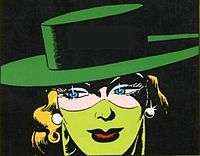Lady Luck (comics)
Lady Luck is an American comic-strip and comic book crime fighter and adventuress created and designed in 1940 by Will Eisner with artist Chuck Mazoujian. She starred in a namesake, four-page weekly feature published in a Sunday newspaper comics insert colloquially called "The Spirit Section", which ran from June 2, 1940 to November 3, 1946.[1] Her adventures were reprinted in comic books published by Quality Comics.[2] A revamped version of the character debuted in 2013 in DC Comics's Phantom Stranger comic.

Lady Luck is the alter-ego of Brenda Banks, a young Irish-American socialite heiress, daughter of a mine-owner. Rejecting her vapid debutante circle, she trains in martial arts and adopts the persona of a costumed detective.[3] Her costume consists of a green dress, a large green hat, and a green veil in place of a mask. In some early versions, representations of lucky charms hang from her hat brim. Like Denny Colt, hero of The Spirit, she does not possess any supernatural abilities. Her love interest in the strip is Police Chief Hardy Moore, and she's also assisted by the incompetent Officer Feeny O'Mye. Neither of them knows her true identity.[3] During the war, she leads the girls of the Lady Luck Patrol.[4]
Publication history
Created and designed in 1940 by Will Eisner (who wrote the first two Lady Luck stories under the pseudonym "Ford Davis")[5] with artist Chuck Mazoujian, Lady Luck appeared in her namesake, four-page weekly feature published in a Sunday-newspaper comic-book insert colloquially called "The Spirit Section" (syndicated by the Register and Tribune Syndicate).
This 16-page, tabloid-sized, newsprint comic book, sold as part of 20 Sunday newspapers with a combined circulation of as many as five million, starred Eisner's masked detective the Spirit and also initially included the feature Mr. Mystic,[6] plus filler material. Writer Dick French took over scripting after these first two episodes.[7] Later, writer-artist Nicholas Viscardi (later known as Nick Cardy) took over the feature from the May 18, 1941 strip through Feb. 22, 1942, introducing Lady Luck's chauffeur and assistant, Peecolo.[8] Though his Lady Luck stories were credited under the house pseudonym Ford Davis, Viscardi would subtly work in the initials "NV" somewhere into each tale.[9] Writer-artist Klaus Nordling followed, from the March 1, 1942 to March 3, 1946 strip, when "Lady Luck" was temporarily canceled. After briefly being replaced by the humor feature "Wendy the Waitress" by Robert Jenny, "Lady Luck" returned from May 5 to November 3, 1946, under cartoonist Fred Schwab.[8]
"Lady Luck" stories were reprinted in the Quality Comics comic book Smash Comics #42-85 (April 1943 - Oct. 1949), whereupon the series changed its title to Lady Luck for five more issues.[10] Nordling providing new seven- to 11-page stories in Lady Luck #86-90 (Dec. 1949 - Aug. 1950), with Gill Fox drawing the covers. Occasional backup features were "Lassie" by writer-artist Bernard Dibble and the humor features "The Count", by Nordling, and "Sir Roger", by Dibble or, variously, Bart Tumey.[11]
Lady Luck was revived alongside Eisner characters John Law, Nubbin, and Mr. Mystic in IDW Publishing's Will Eisner's John Law: Dead Man Walking, a 2004 collection of new stories by writer-artist Gary Chaloner.
In 2011, Lady Luck was ranked 84th in Comics Buyer's Guide's "100 Sexiest Women in Comics" list.[12]
DC Comics' The New 52
On July 23, 2011, writer Geoff Johns announced that a new version of the character would be featured in his upcoming revamp (with artist Jim Lee) of DC Comics' Justice League, as part of the New 52.[13]
On December 10, 2012, DC's solicitations for comics shipping in March 2013 revealed that the new version of Lady Luck would be making her debut in The Phantom Stranger #6, written by Dan DiDio.[14]
References
- Holtz, Allan (2012). American Newspaper Comics: An Encyclopedic Reference Guide. Ann Arbor: The University of Michigan Press. p. 229. ISBN 9780472117567.
- Koolman, Mike; Amash, Jim (2011). The Quality Companion. TwoMorrows Publishing. pp. 141–142. ISBN 978-1605490373.
- Mitchell, Kurt; Thomas, Roy (2019). American Comic Book Chronicles: 1940-1944. TwoMorrows Publishing. p. 35. ISBN 978-1605490892.
- Nevins, Jess (2013). Encyclopedia of Golden Age Superheroes. High Rock Press. p. 155. ISBN 978-1-61318-023-5.
- Horn, Maurice (1996). 100 Years of American Newspaper Comics. Gramercy. p. 173. ISBN 978-0517124475.
- Mr. Mystic Archived 2011-01-16 at WebCite at Wildwood Cemetery: The Spirit Database. WebCitation archive.
- Lady Luck Archived 2011-10-25 at WebCite at Don Markstein's Toonopedia. Archived from the original on October 23, 2015.
- "Lady Luck" Archived 2011-01-16 at WebCite at Wildwood Cemetery: The Spirit Database. Accessed January 16, 2010. WebCitation archive.
- Nick Cardy official site: Biography
- Benton, Mike (1992). Superhero Comics of the Golden Age: The Illustrated History. Dallas: Taylor Publishing Company. p. 169. ISBN 0-87833-808-X. Retrieved 8 April 2020.
- Lady Luck at the Grand Comics Database
- Frankenhoff, Brent (2011). Comics Buyer's Guide Presents: 100 Sexiest Women in Comics. Krause Publications. p. 53. ISBN 978-1-4402-2988-6.
- Parkin, JK (July 23, 2011). "Lady Luck revealed as mystery Justice League member". Comic Book Resources. Archived from the original on February 12, 2012. Retrieved February 12, 2012.
- "DC Comics' FULL March 2013 Solicitations". Newsarama. Retrieved 2017-09-07.
External links
- Will Eisner's John Law official site
- Last of the Spinner-Rack Junkies: Lady Luck #86 (Dec. 1949): 11-page story by Klaus Nordling; cover art by Gill Fox, "Lady Luck" four-page story by Klaus Nordling, and "Lady Luck" four-page story by Klaus Nordling
- Pure Excitement Comics: "Lady Luck" four-page story with Count Dichange, by Klaus Nordling
- Comic Book DB-Lady Luck